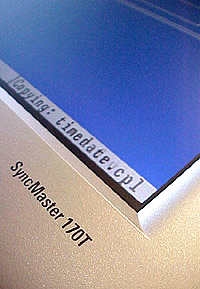The monitor test program is
often very useful at picking out points where the monitor
may be less than perfect. These tests are very strenuous and are designed to
stress the display in ways you might not normally see.
TFT
displays typically
pass all of the tests without
any questions, but there are a few areas where differences
begin to expose themselves. On this particular display we noticed a few things about
the 170T that set it aside from the 180T we reviewed previously.
During the tests for brightness and contrast the display seemed exhibit
difficulties on the lower end of the scale. The shades run from 1% to 9% white,
and should be distinct, but the TFT panel seemed to group them in the following
manner;1-2, 3-4, 5-6, 7-8, and 9%. Moire also seemed problematic for one
particular test pattern. When either the 1pixel solid bar, alternating between
black and white, or the 1pix black and white checker were displayed the display
produced thin distortion lines in the horizontal plane.

Speaking from experience, every LCD display will
experience this issue if it is improperly focused, but given the fact that we
were unable to adjust the settings to resolve the discrepancy it may very well
be an issue with the particular TFT panel.
In all other instances the 170T performed flawlessly,
producing vivid and extremely sharp images that worked well in either the gaming
or office environments. With a good refresh rate of 25ms per pixel there was no
evident ghosting or streaking that we could detect.
Final Conclusions
With the classic Samsung control panel
on the front bezel that features that nifty back-lit power/standby button and the simple but
effective display controls the 170T is an uncomplicated display to work with.
 The panel used on
the 170T model features an industry standard
for high end viewing angle of 80/80/80/80 and a good brightness of 220 cd/m2.
It's often difficult to look at one display and say that it is brighter than another one,
but from what we have reviewed, 300cd/m2 is value to be comfortable with.
The panel used on
the 170T model features an industry standard
for high end viewing angle of 80/80/80/80 and a good brightness of 220 cd/m2.
It's often difficult to look at one display and say that it is brighter than another one,
but from what we have reviewed, 300cd/m2 is value to be comfortable with.
Contrast is top of the line at 350:1, and with
a pixel pitch of 0.281 you shouldn't experience any problems with displays
appearing to blocky or rigid. I know when I first started
using a laptop (a now aging Acer 512T this is being written
on - anybody at Acer feel like sending a notebook over for review?) it took me quite
some time to get used to the ultra-sharp text that seemed too stiff.
CRT displays excel at producing clear and crisp pictures
with little discernable difference from pixel to pixel. LCD display's by their
nature are forced to adhere to a matrix of blocks and there is little room for
the eye to blend lines into smooth flowing objects.
This is a very nice display to work with despite its one
or two shortcomings where the test patterns are concerned. The size difference
from 18.1" to 17" often comes with a substantial cost reduction, so do yourself
a favor and consider the 170T for your next display upgrade. It's almost
guaranteed that you'll like it better than those boring old beige displays the
are cluttering up your co-workers desk!

